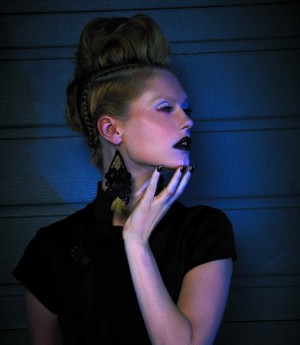(Dark) Future Perfect
What’s in your wardrobe: pastels, earth tones, or maybe stripes? What about black?
Yes, black — and not just the ubiquitous dress of a certain small size. In 2013, black — that much-maligned color often seen as more suited for a funeral than the boardroom or a stylish night out — is all the rage amidst its maturation in the eyes of designers.
Is it a bit on the Goth side? Perhaps, but the color of shadows is most definitely in vogue at the moment.
The darkly glamorous look has escaped the sullen shadows of the ’90s, only to reappear in a new — and entirely more sophisticated — light on runways and in boutiques from Boston to Baku. It has certainly expanded beyond the stereotypical witchy attire in the past few years.
Alexander McQueen fell for Goth’s spell. So too did Thierry Mugler, Christian Lacroix, and Jean-Paul Gaultier. Gareth Pugh, Ann Demeulemeester and Yohji Yamamoto have also shown a tendency for shadowy inclination from time to time.
These designers have also helped with the aesthetical evolution of the Goth look: forget any preconceived notions about black velvet, lace, Halloween stores and old Bauhaus records.
Instead, enter the future. And it’s not as dark as one might think. At least, not in the movement’s epicenter: Toronto.
Want proof?
Try Futurstate, a forward-thinking label that doesn’t even bear the name of designer Laura Stewart. Featuring stunning black-on-black patterns and durable, easy-to-wear modernist fabrics, texturing is a strength of Stewart’s designs. “I think it’s important for the garments to be easy to care for and to be able to be worn time and time again,” she says. “I like working with modern textiles with interesting coatings, techno fabrics, and searching for interesting hardware. I also enjoy designing prints and using reflective materials.”
With a constantly evolving selection of womenswear and menswear, part of the power of Futurstate clothing, Stewart believes, is in its transformational nature — its ability to let one adopt a persona and apply for whatever situation they find themselves in, be it a day at the office, a night out, or a weekend getaway.
“I am constantly fascinated by the transformational nature of clothing. The way it can make someone feel more like themselves or how it can express an inner idea of self to the world,” she says. “It’s an evolving concept that can always be explored. Reaching people and giving them a means to express themselves visually is always challenging. Ultimately, tapping into what makes people feel good, empowered, and strong through dressing is something that drives me.”
Particularly known for its breathtaking tops and innovative skirts, which were on full display during a scintillating runway show at Fashion Art Toronto (FAT) on April 25, Stewart’s inspiration for the label came from her time living and working in London — an experience that helped form the basis of what would one day become Futurstate. Going to concerts and visiting independent shops on Queen Street West and Kensington Market left their mark, as did trips to legendary vintage shop The Black Market. Access to sewing machines helped too.
“I was lucky enough that my landlord happened to have a room full of industrial sewing machines,” says Stewart. “I spent my free time designing outfits to wear out clubbing, always being challenged to create a more unique style that would get noticed [by] all the amazingly dressed guests at the clubs.”
When she returned to the land of ice hockey and butter tarts, she decided to dive head-first into the thriving Toronto fashion scene, the largest in Canada and one of the most competitive in all of North America.
“Upon coming back to Canada, I became involved in the fashion industry in Toronto and soon took the leap to follow my dream,” Stewart says. “I wished to make the collection available to alternative communities around the world. I started selling locally and launched the Futurstate Web site soon afterward.”
The idea of clothing serving as a type of armor — masking who a person might be and protecting their inner self while projecting an image of strength and confidence — was also an inspiration for going into fashion design, she says.
“It started when I was growing up. I felt uncomfortable in regular clothing,” explains Stewart. “I started to redesign secondhand clothing and made attempts at making garments from scratch or commercial patterns. I didn’t want to look like anyone else. I used fashion as a way to express myself. Being shy at times, I used clothing as a combination of intrigue and armor.”
Today, Stewart’s love of modernity is what drives many of Futurstate’s futuristic designs. “I love modernity and the creative freedom that comes from designing something futuristic,” explains the designer. “It can be very imaginative. I love to daydream about a new world in the future. I’m intrigued by the contrast of a slick looking future but I’m equally interested in a degenerated apocalyptic-dystopian future. I enjoy the tension between those oppositions. Sci-fi films have always been a not-so-guilty pleasure of mine.”
With 2013 marking Futurstate’s 10-year anniversary, big things are in store for the label. The FAT show teased viewers with the label’s fashionably devious plans, fitting perfectly with the evening’s theme of “CRISIS.” Hard-edged and unflinching, inspiration for the collection included sci-fi, fetish, post-apocalyptic visuals and dystopian daydreams, showcasing an extremely structured, utilitarian-militant look for men and womenswear, ranging from sharply-refined industrial to a sleek and decadent design, with an underground aristocratic feel. The overall mood of this collection is striking, powerful and invincible.
In other words, it’s a good time to go dark — very dark.

Featured image: Model: Christine MacGibbon. Stylist: Pretty Deadly Stylz. Hair Stylist / MUA: Jesse Young. Photo Credit: Ian Compton.

